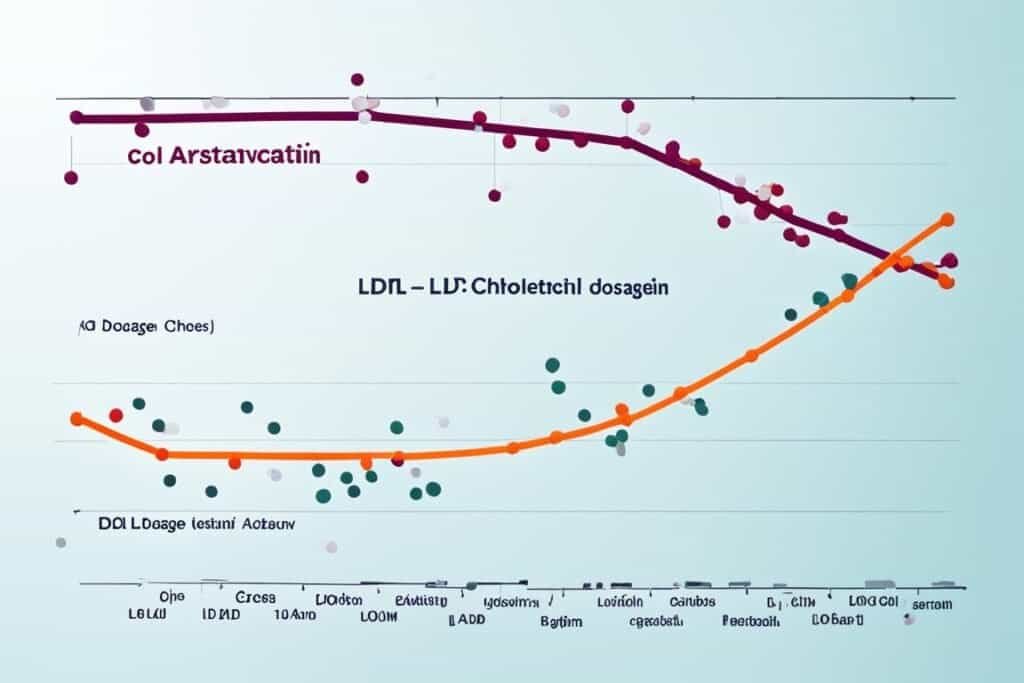Welcome to our article on the role of Atorvastatin in lowering LDL cholesterol. If you’re concerned about managing your cholesterol levels and improving your cardiovascular health, understanding the effectiveness of this cholesterol-lowering medication is essential. Atorvastatin is widely prescribed in cholesterol management due to its ability to target LDL cholesterol specifically.
LDL cholesterol, often referred to as “bad” cholesterol, plays a significant role in increasing the risk of cardiovascular diseases such as heart attacks and strokes. Lowering LDL cholesterol levels is crucial for reducing these risks and maintaining overall cardiovascular health. Atorvastatin has proven to be a valuable tool in achieving this goal.
In this article, we will explore the efficacy of Atorvastatin in reducing LDL cholesterol and its other benefits in managing lipid profiles. We will also discuss the safety and adherence of Atorvastatin therapy, as well as the importance of choosing the right dosage. By the end, you will have a comprehensive understanding of Atorvastatin’s role in cholesterol management and its contribution to improved cardiovascular health.
Before we delve into the details, let’s take a moment to visualize the impact of Atorvastatin in lowering LDL cholesterol:
Key Takeaways:
- Atorvastatin is an effective medication for managing cholesterol levels.
- Lowering LDL cholesterol is crucial for improving cardiovascular health.
- Atorvastatin leads to significant reductions in LDL cholesterol levels.
- It also improves other lipid parameters, such as total cholesterol and triglycerides.
- Adherence to Atorvastatin therapy is associated with better cardiovascular outcomes.
Understanding Cholesterol and its Impact on Cardiovascular Health
High cholesterol levels, particularly LDL cholesterol, can significantly increase the risk of developing cardiovascular diseases such as chest pain, heart attacks, and strokes. Lowering LDL cholesterol is crucial for reducing the risk of these cardiac events and improving overall cardiovascular health. Atorvastatin is a widely used medication that effectively targets LDL cholesterol and helps in managing hypercholesterolemia.
Cholesterol is a waxy substance produced by the liver and obtained from certain foods. It is essential for the body’s normal functioning, playing a vital role in cell membrane formation, hormone production, and bile acid synthesis. However, when cholesterol levels in the blood become too high, it can lead to a buildup of plaque in the arteries, restricting blood flow and increasing the risk of cardiovascular diseases.
LDL Cholesterol and Cardiovascular Risk
LDL cholesterol, often referred to as “bad” cholesterol, carries cholesterol from the liver to the cells and tissues throughout the body. However, excessive LDL cholesterol levels can contribute to the formation of artery-clogging plaque. This can ultimately lead to atherosclerosis, a condition characterized by narrowed and hardened arteries, which increases the risk of heart attacks, strokes, and other cardiovascular events.
Lowering LDL cholesterol is critical in managing cardiovascular risk. By reducing LDL cholesterol levels, the progression of atherosclerosis can be slowed down, and the risk of cardiovascular events can be minimized.
| Cardiovascular Event | Risk Reduction with Lower LDL Cholesterol |
|---|---|
| Heart attacks | Up to 50% |
| Strokes | Up to 33% |
| Chest pain (angina) | Up to 34% |
Table: Risk Reduction with Lower LDL Cholesterol
Managing Hypercholesterolemia with Atorvastatin
Atorvastatin belongs to a class of medications called statins, which work by inhibiting an enzyme involved in cholesterol synthesis. By reducing cholesterol production in the liver, Atorvastatin helps lower LDL cholesterol levels and improves overall cholesterol balance in the body. This, in turn, reduces the risk of cardiovascular events and promotes better cardiovascular health.
Atorvastatin is commonly prescribed to individuals with hypercholesterolemia, a condition characterized by high levels of LDL cholesterol. It is important to note that proper lifestyle modifications, such as adopting a healthy diet, regular exercise, and weight management, should also be incorporated alongside Atorvastatin therapy to achieve optimal cholesterol management and cardiovascular health.
Efficacy of Atorvastatin in Lowering LDL Cholesterol
Multiple studies have demonstrated the effectiveness of Atorvastatin, a cholesterol-lowering medication, in reducing LDL (low-density lipoprotein) cholesterol levels. Compared to other lipid-lowering drugs like Simvastatin, Atorvastatin has shown superior results in lowering LDL cholesterol.
In clinical trials, Atorvastatin consistently led to greater reductions in LDL cholesterol levels. It has been observed that more patients taking Atorvastatin achieve the LDL cholesterol goals established by the National Cholesterol Education Program (NCEP).
Atorvastatin is considered a potent and reliable medication for individuals with high LDL cholesterol levels. Its efficacy in lowering LDL cholesterol makes it a valuable option in cholesterol management.

Comparative Efficacy of Atorvastatin and Simvastatin
To highlight the superiority of Atorvastatin in lowering LDL cholesterol, let’s compare its efficacy with Simvastatin, another commonly prescribed lipid-lowering drug.
| Atorvastatin | Simvastatin | |
|---|---|---|
| Reduction in LDL Cholesterol | Greater reductions observed | Comparatively lower reductions |
| Achievement of LDL Cholesterol Goals | More patients achieve goals | Less patients achieve goals |
The data clearly indicates that Atorvastatin outperforms Simvastatin in lowering LDL cholesterol levels and helping patients reach their cholesterol goals.
Other Benefits of Atorvastatin in Cholesterol Management
In addition to lowering LDL cholesterol, Atorvastatin offers several other benefits for managing cholesterol and promoting cardiovascular health. The medication effectively targets various lipid parameters, leading to a comprehensive improvement in lipid profiles.
Atorvastatin can:
- Decrease total cholesterol levels
- Reduce triglyceride levels
- Lower apolipoprotein B levels
- Decrease VLDL cholesterol levels
- Increase HDL cholesterol levels
This combination of effects provides significant support for overall cardiovascular health. By reducing total cholesterol and triglycerides while increasing HDL cholesterol, Atorvastatin helps maintain a favorable lipid profile and lowers the risk of cardiovascular events such as heart attacks and strokes.
To provide a clearer comparison of the positive effects of Atorvastatin on different lipid parameters, here is a table summarizing the changes:
| Lipid Parameter | Effect of Atorvastatin |
|---|---|
| Total Cholesterol | Decreased |
| Triglycerides | Decreased |
| Apolipoprotein B | Decreased |
| VLDL Cholesterol | Decreased |
| HDL Cholesterol | Increased |
This visual representation highlights the positive impact of Atorvastatin on different lipid parameters, emphasizing the medication’s ability to effectively manage cholesterol and improve cardiovascular health.
Safety and Adherence of Atorvastatin Therapy
When it comes to your cardiovascular health, the safety and adherence of Atorvastatin therapy are key factors to consider. Numerous studies have examined the use of Atorvastatin and its effects on patient outcomes. The good news is that Atorvastatin is generally well-tolerated, with minimal adverse effects.
While some individuals may experience muscle pain, aches, or weakness as potential side effects, these occurrences are uncommon. Additionally, some patients may witness increases in liver enzymes or creatine phosphokinase levels. However, severe complications such as myositis are rare.
Adherence to Atorvastatin therapy has shown significant benefits in improving cardiovascular disease outcomes and reducing mortality rates. By following your prescribed treatment plan and taking Atorvastatin as directed, you can lower the risk of cardiovascular events and improve your overall health.

Risk Factors and Considerations
While Atorvastatin is generally safe and well-tolerated, it’s important to be aware of certain risk factors and considerations. Before starting Atorvastatin therapy, it is crucial to discuss your medical history and any pre-existing conditions with your healthcare provider.
Some recent studies have suggested a potential link between Atorvastatin and an increased risk of developing type 2 diabetes, particularly in older adults. However, the overall benefits of Atorvastatin in lowering LDL cholesterol and reducing cardiovascular risk still outweigh the potential risks in most individuals.
Monitoring and Follow-Up
To ensure your safety and monitor the efficacy of Atorvastatin therapy, regular check-ups and laboratory tests are essential. Your healthcare provider will monitor your lipid profile, liver enzymes, and creatine phosphokinase levels to assess the effectiveness of the medication and detect any potential side effects.
| Monitoring Parameters | Suggested Frequency |
|---|---|
| Lipid profile (including LDL cholesterol levels) | Every 3 to 12 months (depending on initial levels) |
| Liver enzymes (ALT, AST) | Within 12 weeks of starting therapy and as needed thereafter |
| Creatine phosphokinase (CPK) | If muscle pain or weakness develops or as needed based on symptoms |
Regular follow-up appointments with your healthcare provider will ensure that your treatment plan is optimized, and any necessary adjustments can be made to meet your cholesterol goals and maintain your cardiovascular health.
Choosing the Right Atorvastatin Dosage
The dosage of Atorvastatin plays a crucial role in achieving optimal reductions in LDL cholesterol and meeting cholesterol goals. Several studies have compared the efficacy of starting dosages and maximal dosages of Atorvastatin with other statins. These studies have shown that higher doses, such as 80 mg, of Atorvastatin can lead to greater reductions in LDL cholesterol compared to lower doses.
However, it is important to note that the choice of dosage should be individualized based on various factors. These factors include the patient’s current cholesterol levels, overall health, and response to therapy. Your doctor will evaluate these factors and determine the most appropriate dosage of Atorvastatin to help you achieve your cholesterol goals.
It is essential to follow your doctor’s instructions regarding the dosage and timing of Atorvastatin. Taking the medication as prescribed will maximize its effectiveness in reducing LDL cholesterol and improving your overall cardiovascular health.
Conclusion
Atorvastatin is a vital medication for managing cholesterol and promoting cardiovascular health. It effectively lowers LDL cholesterol levels, reducing the risk of heart diseases such as heart attacks and strokes. Not only does Atorvastatin target LDL cholesterol, but it also improves other lipid parameters, including total cholesterol and triglycerides.
When used as directed, Atorvastatin is generally well-tolerated, with minimal side effects. It is crucial to adhere to the prescribed therapy to maximize its benefits for cardiovascular outcomes. Choosing the appropriate dosage of Atorvastatin is essential for achieving optimal cholesterol reductions, based on individual patient factors and cholesterol goals.
In conclusion, Atorvastatin is a valuable tool in cholesterol management, contributing to better cardiovascular health. By effectively lowering LDL cholesterol and improving lipid profiles, Atorvastatin plays a crucial role in ensuring a healthy heart. If you are concerned about high cholesterol levels and their impact on your cardiovascular health, consult your healthcare professional to see if Atorvastatin is a suitable option for you.

